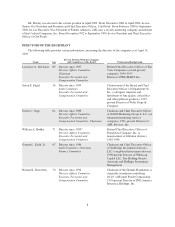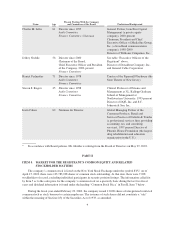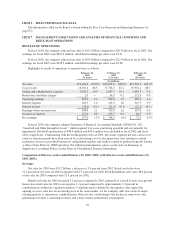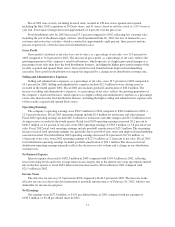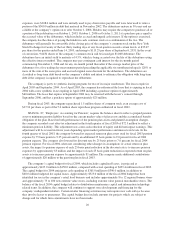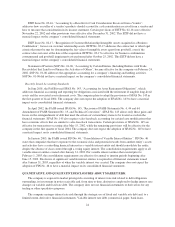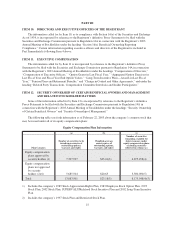Albertsons 2003 Annual Report Download - page 18
Download and view the complete annual report
Please find page 18 of the 2003 Albertsons annual report below. You can navigate through the pages in the report by either clicking on the pages listed below, or by using the keyword search tool below to find specific information within the annual report.Reserves for Self Insurance
The company is primarily self-insured for workers’ compensation and general and automobile liability
costs. It is the company’s policy to record its self-insurance liabilities based on claims filed and an estimate of
claims incurred but not yet reported, discounted at a risk free interest rate. Any projection of losses concerning
workers’ compensation and general and automobile liability is subject to a considerable degree of variability.
Among the causes of this variability are unpredictable external factors affecting future inflation rates, discount
rates, litigation trends, legal interpretations, benefit level changes and claim settlement patterns. A 100 basis
point change in discount rates, based on changes in market rates would increase the company’s liability by
approximately $1.0 million.
Retirement Plans
The company sponsors pension and other retirement plans in various forms covering substantially all
employees who meet eligibility requirements. The determination of the company’s obligation and expense for
pension and other post retirement benefits is dependent, in part, on management’s selection of certain
assumptions used by its actuaries in calculating these amounts. These assumptions include, among other things,
the discount rate, the expected long-term rate of return on plan assets and the rates of increase in compensation
and health care costs. In accordance with generally accepted accounting principles, actual results that differ from
the company’s assumptions are accumulated and amortized over future periods and, therefore, affect its
recognized expense and recorded obligation in such future periods. While the company believes that its
assumptions are appropriate, significant differences in actual experience or significant changes in assumptions
may materially impact pension and other post retirement obligations and future expenses.
In the fourth quarter of fiscal 2003, the company lowered its expected return on plan assets used for fiscal
2003 pension expense by 75 basis points to 9.25 percent and by an additional 25 basis points to 9.0 percent for
fiscal 2004 pension expense. The company also lowered its discount rate by 25 basis points to 7.0 percent for
fiscal 2004 pension expense. For fiscal 2004, when not considering other changes in assumptions, the impact to
pension expense of each 25 basis point reduction in the discount rate is to increase pension expense by
approximately $3 million and the impact of each 25 basis point reduction in expected return on plan assets is to
increase pension expense by approximately $1 million.
The assumed health care cost trend rate used in measuring the accumulated post retirement benefit
obligation was 9.0 percent in fiscal 2003. The assumed health care cost trend rate will decrease by one percent
each year for the next four years until it reaches the ultimate trend rate of 5.0 percent. The health care cost trend
rate assumption has a significant impact on the amounts reported. For example, a one percent increase in the
trend rate would increase the accumulated postretirement benefit obligation by $6.7 million and the net periodic
cost by $0.5 million in fiscal 2003. In contrast, a one percent decrease in the trend rate would decrease the
accumulated post retirement benefit obligation by $6.3 million and the net periodic cost by $0.5 million in fiscal
2003. The weighted average discount rates used in determining the benefit obligation were 7.0% and 7.25% for
fiscal 2003 and 2002, respectively.
Goodwill
Management assesses the valuation of goodwill for each of the company’s reporting units on an annual basis
through the comparison of the fair value of the respective reporting unit with its carrying value. Fair value is
determined primarily based on valuation studies performed by the company, which consider the discounted cash
flow method consistent with the company’s valuation guidelines. Valuation analysis requires significant
judgments and estimates to be made by management. The company’s estimates could be materially impacted by
factors such as competitive forces, customer behaviors, changes in growth trends and specific industry
conditions.
18


